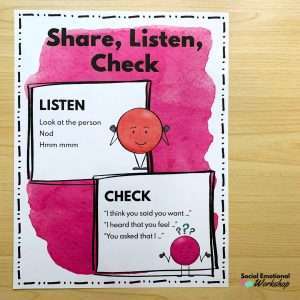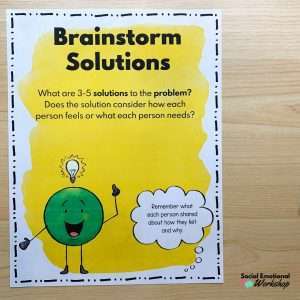Picture this: A group of students is playing during recess when one child is suddenly left out. Hurt feelings start to rise, and before long, it spirals into name-calling and standoffish body language. You’re called in to help—but where do you even start? Conflict resolution is an essential social skill that students will carry throughout their lives.
Instead of responding to every conflict as it arises, how about weaving conflict resolution into daily routines? A proactive approach, like teaching these skills during classroom activities or setting up a dedicated peace corner, empowers students to manage their emotions and solve problems independently. Below, I’ll share some practical, ready-to-use ideas that work for students across grade levels.
Let’s dive in!
Classroom Conflict Resolution Practices
Morning Meetings or Class Circles
These gatherings are more than just a chance to say "good morning"—they’re a golden opportunity to build relationships and give students a opportunity to express themselves.
Goal: Build a foundation for open communication and emotional language.
Kindergarten - First Grade
- Use visual tools like feeling charts to help students articulate their emotions.
- Teach and practice simple scripts like, “I felt [emotion] when [situation].”
- During circle time, try discussing common scenarios students experience—like accident vs on purpose or sharing supplies.
Second - Third Grade:
- Introduce prompts about real-life conflicts and guide students to collaboratively brainstorm resolutions.
- Incorporate role-play with simple skits where students act out a conflict and practice solving it.
Fourth - Fifth Grade:
- Facilitate peer-led discussions, giving older students the chance to share solutions they've successfully used.
- Encourage setting personal conflict-resolution goals and tracking their progress over time.
Collaborative Group Work
Working in groups can quickly get tricky for kids—but it’s also a highly teachable moment!
Goal: Teach students to navigate disagreements while working collaboratively.
Kindgergarten - First Grade:
- Start small. Assign cooperative tasks and step in as needed to guide students through basic conflict resolution strategies.
- Tools like a "job chart" can help define roles and reduce misunderstandings.
Second - Third Grade:
- Before group work begins, create rules for turn-taking and decision-making, giving students a framework.
- Rotate the role of “group leader” to promote fairness and responsibility.
Fourth - Fifth Grade:
- Involve students in creating their own group agreements or charters, laying out how they’ll handle disagreements.
- After tasks are complete, host group reflections to discuss what worked well and what could be improved next time.
Reflective Journals
Writing or drawing about social conflicts helps students build self-awareness over time.
Goal: Foster problem-solving and emotional regulation through personal reflection.
Kindergarten - First Grade:
- Use drawing prompts like “Draw how you felt and how the problem was solved.” Simple and visual!
Second - Third Grade:
- Provide sentence starters to lower the barrier to entry—for example, “One way I solved a problem today was…”
Fourth - Fifth Grade:
- Engage students on a deeper level by asking them to write about patterns they’re noticing in how they handle conflict or the emotions they feel most often.
- Example: Ask them to reflect: “What could you try differently next time a similar problem happens?”
Setting Up a Peace Corner or Table
A peace corner (or table) is a dedicated space where students can independently cool down, reflect, and work through conflicts with structured tools—and a little guidance when needed.
How to Create the Space
- Choose a Quiet Spot: Find a calm, accessible area in the class where students feel they can safely pause.
- Stock It With Tools:
- Emotion charts or posters.
- “I” statement templates.
- Sensory tools like stress balls, sand timers, or fidget items.
- Reflective worksheets or journals tailored to their age group.
- Teach How to Use It: Introduce the peace corner during a class lesson or role-play. Help students see it as a resource, not a punishment.
Grade-Level Modifications
Kindergarten - First Grade:
Visuals work wonders—use posters with calming steps (e.g., “Take a deep breath”) or faces showing different emotions with labels.
Provide step-by-step tools they can follow independently, like matching their feelings to calming strategies or a list of solutions to common problems.
Second - Third Grade:
Include a "solution jar” filled with simple strategies for common problems—e.g., “Take turns” or “Find a way to share.”
Fourth - Fifth Grade:
Offer reflection forms or “conflict contracts” that encourage students to summarize what happened, how they felt, and the agreement they worked out with others.
Practical Tips for Success
Building conflict resolution systems doesn’t have to be overwhelming! Here are some tips to make these strategies manageable for you and meaningful for your students:
Model the Process: Show them what constructive conflict resolution looks like. Narrate your thought process as you de-escalate a pretend disagreement with another adult or even a puppet. Post: Teaching Conflict Resolution Skills in 6 Easy Steps
Reinforce Skills Regularly: Make conflict resolution a weekly practice, whether through a mini-lesson or by pausing during group activities to address real moments collaboratively.
Celebrate Wins—Big or Small: When a student uses the peace corner effectively or resolves a conflict independently, recognize it. Even a simple shout-out during morning meeting can help cement their confidence.
When conflict resolution becomes part of your students’ daily routines, you’re not just reducing disruptions in the moment—you’re equipping them with lifelong tools for managing emotions and relationships. And, with supports like a peace corner in place, kids will feel empowered to handle challenges independently.
What about you? Do you have a favorite strategy for helping kids navigate conflicts? I’d love to hear your thoughts - share them in the comments below!
Resources In This Post

Conflict Resolution Lesson
resource description

Conflict Resolution Worksheets
resource description



